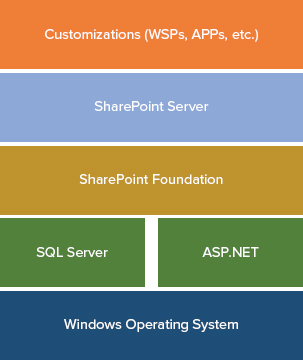SHAREPOINT 2013: THE PLATFORM
SharePoint maintains a high-level architecture that is made up of a number of components (see Figure 1-7). You first install the core software on Windows so you can create SharePoint farms. A SharePoint farm is, in essence, one or more servers that make up your SharePoint instance. As a developer you should understand the three-tiered structure and roles of the SharePoint farm architecture, which includes a Web server role (a fast, load-balanced, lightweight server that responds to user requests and loads Web pages), Application server role (which provides the service features for SharePoint such as Excel Services), and Database server role (which stores content and service data). Your apps may interact with any one or all of these server roles.
You can have a standalone server acting as the entire farm (for example, all the components listed in Figure 1-7 installed or working on one machine). For testing and light workloads, this configuration might be adequate, depending on the hardware specifications. For larger organizational deployments, inclusive of failover and redundancy, a one-server farm is not adequate. However, the Windows operating system is your underlying install base — specifically, Windows Server 2008, 2008 R2, and Windows Server 2012. SharePoint heavily leverages SQL Server as its underlying content database and ASP.NET/IIS ...
Get Beginning SharePoint 2013 Development now with the O’Reilly learning platform.
O’Reilly members experience books, live events, courses curated by job role, and more from O’Reilly and nearly 200 top publishers.


